Private Scuba Divers › Sea Life Creatures › Weird Fish Names
Weird Scientific Names for Fishes
The naming of fish species has always been a job best done by scientists. But, every once in a while they come up with a fish name that is weird, funny, and sometimes - rather rude.
This section contains a list of unusual and funny scientific names for fishes, and the thought process behind these weird names for marine animals.
Marine Animals with the Weirdest of Names
There are 1,305,075 extant invertebrate species on earth - according to estimates from the International Union for Conservation of Nature (IUCN).
In addition, the number of vertebrate animals with a spinal column is thought to be around 62,000.
Here's the thing:
A recent tally of living fish species is said to be about 33,000 - and the marine biologists had to come up with an "appropriate" name for every single one of them!
So, our team thought it would be a good idea to list fish names that are either humorous, comical, unfathomable, or downright risqué!
We hope you get a giggle somewhere down the page and please send us an email if we missed anything funnier or weirder.
In no particular order...
Bombay Duck (Harpadon nehereus)
There are several obscure names used for these elongated eel-like types of lizardfish, including bummalo, loitta, boomla, bombili, and lote.
Archives suggest Robert Clive (first British Governor of the Bengal Presidency) first coined the term after tasting its flesh during his conquest.
The Bombay duck fish is a significant annual catch from the waters off Maharashtra, in the Lakshadweep Sea.
Fun Fact: Several decades ago, the UK consumed 13 tonnes of Bombay duck each year. But, in 1996 the European Commission banned fish imports from India after the discovery of contaminated seafood. Later, the 'Save Bombay Duck' campaign persuaded the EU to adjust their strict regulations.
Gummy Squirrel (Psychropotes longicauda)
One of the most unusual of all sea cucumbers is commonly known as the "gummy squirrel", a species of deep-sea holothurian within the family Psychropotidae.
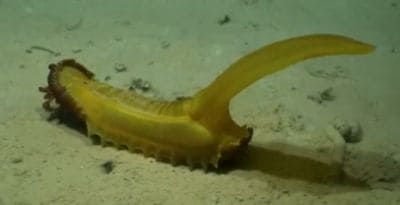 Psychropotes longicauda is one of the "abyssal" sea cucumber species that live on the seabed of some of the deepest oceans on the planet.
Psychropotes longicauda is one of the "abyssal" sea cucumber species that live on the seabed of some of the deepest oceans on the planet.
Holothuroidea is a classification within the phylum Echinodermata that contains around 1,200 different species of sea cucumber.
They're sloth-like scavengers that slowly roam around various benthic zone environments searching for food scraps.
The quirky nickname is one of the funniest fish names invented by marine biologists. Even so, its squidgy gummy-looking appearance, bright yellow colouration, and long sail-like tail, somewhat justifies the cute moniker.
They have a cylindrical body shape with a flattened belly. The most recent results from deep-sea imagery suggest the yellowish upper surface blends into a red under-belly with similar coloured feeding palps.
Fully grown adults generally grow to about eighty (80) centimetres long (30 inches), if you include the tail portion.
Slobbering Catfish (Brachyplatystoma platynemum)
Despite its peculiar name, this potamodromous demersal fish completes its entire life cycle in freshwater. In other words, they thrive at the bottom of the Amazon, many parts of northwestern Brazil, Venezuela, and Colombia.
But, this could be one of the stupidest fish names we've come across because the slobbering catfish doesn't actually slobber. Instead, fishermen thought the long, flattened barbels that extend from the fish's mouth looked like strings of drool. Hence, the silly fish name of "slobbering catfish".
Boxing Crab (Lybia tessellata)
One of the smallest examples of mud crabs also happens to be one of the most active - and very brightly coloured.
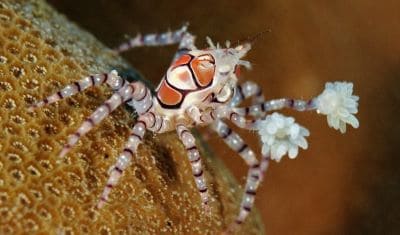 Yet, the so-called boxing crab is best known for carrying anemones in its front claws.
Yet, the so-called boxing crab is best known for carrying anemones in its front claws.
For the most part, you will find Lybia crabs inhabiting shallow sand and gravel seabeds where their natural camouflage works best.
This particular species of Lybia crab is notable for its mutualistic relationship with living sea anemones.
In fact, it looks like the pom pom crab (also called the cheerleader crab) is carrying fluffy tassels or wearing boxing gloves. But, they hold the anemone in their claws as a defence mechanism.
Pro Tip: The sea anemone (Actiniaria) also benefits from this special partnership. Being carried around in the crab's forward pincers (chelae) helps it capture food particles with its flowing tentacles.
The Jack Dempsey Fish (Rocio octofasciata)
We had to add the Jack Dempsey cichlid into our list of funny named fish species. In the wild, you can find them in the freshwater environments of Honduras and southern Mexico.
However, compared with some of the other creative names for fish in the ocean, the aggressive nature and strong facial features are the grounds for naming it after the famous American boxer "Jack Dempsey" from the early 1920s.
Nervous Shark (Carcharhinus cautus)
For all intents and purposes, inappropriate fish names - especially the names of sharks - do not get much more appropriate than the nervous shark, one of the requiem sharks.
The, not so stupid fish name, describes a timid shark with the usual fusiform body shape (like a torpedo or spindle).
Here's the thing:
These one-metre long shy marine creatures are difficult to approach and nowhere near the deadliest shark to humans.
One reason for the shark's nervousness or diffidence could be that we market it for food, especially in PNG and northern Australia. This particular shark species is susceptible to 'incidental' bycatch because it lives in shallow, coastal water.
Sarcastic Fringehead (Neoclinus blanchardi)
This funny fish name sounds more like an 80s rock band. But, N. blanchardi are types of blenny fish found in huge numbers along the coast of California.
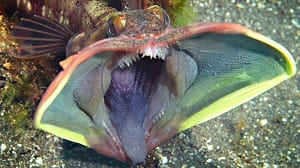 It's a 'deceptively' small creature, and it would be rare to see them longer than twenty five (25) centimetres (10 inches).
It's a 'deceptively' small creature, and it would be rare to see them longer than twenty five (25) centimetres (10 inches).
But, make no mistake, sarcastic fringeheads are both fearless and aggressively territorial.
It will make a charge towards anything that gets anywhere near its burrow.
Scientists must have witnessed their temperament when they attributed the common name 'sarcastic'. And the fringehead part? It has to be the distinctive supraorbital appendages on top of their eyes.
Further research suggests that the 'spectacularly ugly' sarcastic fringehead (Neoclinus blanchardi) uses its colourful mouth to communicate.
Lipstick Dottyback (Pseudochromis kristinae)
It's fair to say the most striking feature of all dottyback fishes is an intensity of colouration. For example, the body colour of the orchid dottyback (Pseudochromis fridmani) is vivid violet with a narrow black stripe running over its head.
The lipstick dottyback (Pseudochromis kristinae) likely gets its alias from a bright red, pink, or magenta colouration that mimics the appearance of lipstick. It could even be linked to another species, such as the Strawberry Dottyback (Pseudochromis porphyreus), or a similar vibrant variant.
Lumpsucker Fish (Cyclopterus lumpus)
There can only be one reason why a zoologist would call a fish species 'lumpsuckers'. This lumpy fish looks like a ball and it has a special sucker for sticking onto rocky substrates.
Having a portly, globular body shape helps to protect the lumpsucker fish (Cyclopterus lumpus) against the breaking waves in the cold waters of the North Atlantic.
The lumpfish sucker is an adaptation of fused pelvic fins. Most of the male species have some kind of bony tubercles, often appearing as wart-like decorations on the head and body.
Slippery Dick Wrasse (Halichoeres bivittatus)
So, let's keep things polite and very professional. In fact, Halichoeres bivittatus (slippery dick fish) is one of the 500+ species of wrasses.
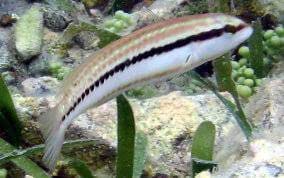 You will find many of them thriving in shallow waters from Bermuda to Brazil (e.g. the western Atlantic Ocean).
You will find many of them thriving in shallow waters from Bermuda to Brazil (e.g. the western Atlantic Ocean).
But, why would anyone with a good command of the English language name a fish 'slippery dick'?
Here's the answer.
This - shall we say 'out of the ordinary' - name for a fish, derives from its ability to secrete a slick, slimy mucus from its skin to evade capture.
In fact, even anglers find it challenging to handle this greasy fish due to their speed and agility in escaping fishing nets and their natural predators - lionfish.
Pro Tip: You can read more about the different wrasse types (Labridae) in the section that covers marine vertebrates.
Sexy Shrimp (Thor amboinensis)
The squat shrimp (Thor amboinensis) is one of the most photogenic of all invertebrate crustaceans found living in shallow reef ecosystems.
This section explains why it's called the sexy shrimp and more about the symbiotic relationship that it has with sea anemones (Actiniaria).
The Black Swallower (Chiasmodon niger)
The eating habits of the black swallower contribute to its unique common name. Yet, despite being one of the funniest fish names in this list, it's actually the most populous fish species in the North Atlantic Ocean (especially the mesopelagic zones).
So, why did scientists give this goofy fish species such a weird sounding name? In fact, this deep sea fish rarely grows longer than fifteen centimetres (6 inches) long.
But, it is capable of devouring prey (mostly bony fish and cephalopods) that are twice as long and up to ten times its own body mass.
Fun Fact: The stomach of a 7-inch dead black swallower found washed ashore off Grand Cayman in 2007 contained a snake mackerel (Gempylus serpens) measuring eighty six (86) centimetres long (34 inches).
Daggernose Shark (Isogomphodon oxyrhynchus)
It's fair to say that most of these fish with weird names have some literal basis for having them. A good example is the daggernose shark (Isogomphodon oxyrhynchus) with its easily identifiable elongated and prominent snout (shaped like a dagger or knife).
Despite their decreasing population (almost to extinction), the best places to see these types of sharks are selected regions of the Caribbean Sea and the central western Atlantic Ocean.
Pro Tip: The IUCN Red List of Threatened Species last assessed the daggernose shark in June 2019 and currently lists them as being Critically Endangered.
Higgins' Eye Pearlymussel (Lampsilis higginsii)
This rare species is actually a freshwater mussel. It is endemic to areas of the upper Mississippi River and the drainages of a few of its tributaries.
In fact, the life history of these marine bivalve mollusks matches the uniqueness of the moniker. It was the first freshwater mussel to get federal protection back in 1972.
Humuhumunukunukuāpuaʻa (Rhinecanthus rectangulus)
Let's state the easy names first. The most common name for it is the reef triggerfish. Some refer to it as the rectangular triggerfish, or even the wedgetail triggerfish.
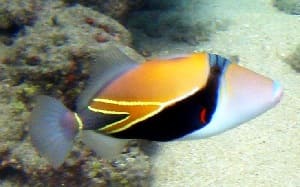 Now, let's try the unpronounceable name that native Hawaiians use... Humuhumunukunukuāpuaʻa.
Now, let's try the unpronounceable name that native Hawaiians use... Humuhumunukunukuāpuaʻa.
Moving on...
Obviously, you can find this fish in Hawaii. But it's also found at some of the coral reefs in the Indo-Pacific.
In a nutshell, the Hawaiian word means "triggerfish with a snout like a pig". Funny fish names don't get much better than that!
Following a campaign in 2006, the Governor reinstated this colourful fish as being the official state fish of Hawaii once again. They even added the lyrics "where the humuhumunukunukuāpuaʻa go swimming by' to a song.
Boops Boops (Bogues)
Our research team keeps finding a plentiful supply of weirdly named fish! Here's one of the oddest - and the reasons behind the name.
In fact the Boops boops fish is a Mediterranean fish and the name comes from the Greek word of "boōps" (translated as "cow-eyed").
It's fair to say the big round eyes do resemble those of a cow - even though it sounds a little ridiculous for an aquatic animal.
Pro Tip: You can learn more about the different types of bream fish (e.g. Sparidea and porgies) in our marine vertebrates section.
Convict Surgeonfish
Having an oval-shaped thin body (laterally compressed) means they can maneuver with ease through tight cracks, crevices, as well as intertwining and branching reef structures (e.g. staghorn corals).
However... convict tangs (Acanthurus triostegus) have six (6) vertical black bar markings that display some resemblance to the barred uniforms of jailed convicts (hence the funny fish name).
Green Humphead Parrotfish (Bolbometopon muricatum)
The scientific name is "B. muricatum", but that's not where the green humphead parrotfish gets its rather quirky appellation.
Instead, the crazy common name for these enormous parrotfishes comes from several distinctive physical features:
 The predominant body colouration of the fish is green. In fact, the bluish-green colours help the adults blend into the coral reef environment in which they live.
The predominant body colouration of the fish is green. In fact, the bluish-green colours help the adults blend into the coral reef environment in which they live.- As you can see from the picture, "humphead" refers to the prominent bulbous hump on top the forehead - especially in adults. Humpheads often use this bony protrusion during "headbutting" behaviour as part of territorial tussles and mating rituals.
- Like most of the parrotfish species, the "beak-like" mouth (formed by fused teeth) resembles the beak of a parrot. The fish uses it to scrape away algae from coral and rocky surfaces.
So now you know, the bumphead parrotfish is one of the weirdest fish names that's a valid description of its colour, head shape, and feeding structure.
Coffinfish (Chaunax endeavouri)
I guess we shouldn't expect marine biologists to give elegant labels to sea toads. But, coffinfish? Really?
Not only is this a weird name for a sea creature, but they look a little strange too. Maybe that's why they are not targeted by commercial fisheries.
Key takeaways:
The coffinfish (Chaunax endeavouri) is capable of holding its breath for four (4) minutes at rest, deep on the ocean floor.
In fact, after inhalation the gills of this sea toad are so big that it can increase its body volume by 30%. To compare, humans would need to inflate their lungs to a size so big that they would match the size of the entire abdomen.
However, that doesn't really tell us why someone named more than twenty different species of coffinfish - coffinfish. One reason could be that this type of anglerfish uses its fins to 'walk' deep down to depths over two kilometres (8,200 feet) on the floor of the ocean.
Earmuff Wrasse (Halichoeres melasmapomus)
Almost all wrasses are small marine fishes, easily identified by their vivid and detailed colours, such as the moon and cuckoo wrasse.
Here's another one of those funny scientific fish names that stretches the imagination for naming animals.
The earmuff wrasse gets its name from the two earmuff-shaped eye-spot rings (ocelli) on either side of its head.
Fun Fact: Further research shows that a few more of the wrasse types make worthy candidates for dumb fish names. For example, we think the disappearing wrasse or striated wrasse (Pseudocheilinus evanidus), and the checkerboard wrasse (Halichoeres hortulanus), should be included in this list.
Dracula Shrimpgoby (Stonogobiops dracula)
The best locations to see the dracula shrimpgoby fish are the shallow reef ecosystems of the Indo-Pacific region, especially at Indonesia dive sites and the top diving spots in the Philippines.
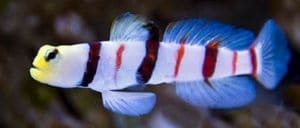 Note the thick stripes of oxblood red that combine elegantly with thinner bands of red-orange and a bright yellow face.
Note the thick stripes of oxblood red that combine elegantly with thinner bands of red-orange and a bright yellow face.
The intriguing symbiotic relationship between the dracula goby and the snapping shrimp (Alpheus randalli) is one reason why aquarists introduce them as part of a fish keeping hobby.
The dracula shrimpgoby is a goby fish that enjoys long-term biological interactions with its burrowmate. It would be unusual to find them living deeper than thirty metres (100 feet) because they thrive best in sandy rubble patches around shallow coral reef environments.
Pro Tip: Our list of aquatic vampire species contains fun facts and interesting information about real-life bloodsuckers that live underwater.
Dumb Gulper Shark (Centrophorus harrissoni)
There are only a handful of dive spots around the world where this endangered deepwater dogfish exists (e.g. the east coast of Australia and the west of New Zealand).
In fact, even though it's one of the gulper sharks, the locals prefer to call it:
- The dumb shark
- Harrison's deep-sea dogfish
- Harrison's dogfish
So, is the dumb gulper shark (Centrophorus harrissoni) a worthy contender for this list of marine animals with the craziest weird fish names?
If so, its pseudonyms must come from the way that it communicates with other animals, such as opening its jaw and head nodding used as gestures.
Red-Lipped Batfish (Ogcocephalus darwini)
The picture shows how appropriate it was for scientists to classify it as the red-lipped batfish. Plus, being a resident of the Galapagos Islands means the locals also dubbed it as the Galapagos batfish.
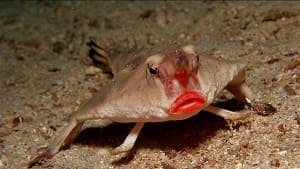 Some of the distinctive features include the bright red, sullen, pouty lips and 'bat-shaped' bone structure.
Some of the distinctive features include the bright red, sullen, pouty lips and 'bat-shaped' bone structure.
In fact, beyond the lipstick aesthetics, biologists think the fish uses the hue for communication and during its courtship rituals.
It might appear odd to some, but this unique feature in red-lipped batfish (Ogcocephalus darwini) may signify a readiness to mate.
There are about 60 types of batfish, and this particular one has modified pectoral and pelvic fins. Yes, it can swim, but it can also walk (more like a shuffle or a wobbly dance) on the seafloor.
Obese Dragonfish (Opostomias micripnus)
The poisonous obese dragonfish (Opostomias micripnus) is one of the largest Melanostomiidae (around 50 centimetres long). Furthermore, it can exist in very deep water - we're talking five kilometres deep.
This deepwater pelagic species has large, fang-like teeth and a long, ugly barbel. It seems to thrive well in the dark abyss environments of the Atlantic, Indian, and Pacific Oceans.
But, it's not a pretty fish, hence the dragonfish reference in the title. And the obese part? Well it does have a pot belly and you wouldn't want to take it home to meet your mom!
Wunderpus Octopus (Wunderpus photogenicus)
It's known as the Wunderpus octopus (Wunderpus photogenicus) because of the German word 'wunder' - which kind of means wonderful or marvellous. But, I guess you already knew that - right?
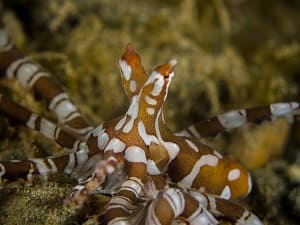 Like most of the octopi species, it has long arms that are good at mimicking other shapes and creatures in the sea.
Like most of the octopi species, it has long arms that are good at mimicking other shapes and creatures in the sea.
But, it's important not to confuse the copper-brown colouring and spectacular patterns with that of the mimic octopus - they are not the same.
In fact, the wonderful wunderpus has a unique white spot on its mantle.
Features such as these, help biologists study and identify different animal and fish species - before naming them.
This particular species is quite new to science literature. Even though they discovered it in the 1980s, they didn't allocate its common name (and 'officially' described it) until 2006.
Oyster Toadfish (Opsanus tau)
Biologists named this ugly Northeast Atlantic fish specimen after two different animals, but it has a whole host of alternative common names, including:
- Bar dog
- Oyster cracker
- Oyster catcher
- Oyster toad
- Ugly toad
It's known for living in the most uninhabitable conditions you could imagine. For example, they are almost invisible in murky waters and muddy oyster beds while they wait to catch their prey.
Pro Tip: NASA sent the Oyster Toadfish (Opsanus tau) into space in 1998. They wanted to test the effects of microgravity on otoliths (balance and hearing organs).
Mouse Fish (Gonorynchus gonorynchus)
This catalog of funny fish names has to include one of the species belonging with the family Gonorynchidae.
Worldwide, the temperate continental shelves are some of the best places to find mouse fish, but especially Norway.
Some alternative common names for the fish with an elongated and pointed rat or mouse-like tail, include the ratfish, sand eel, and the sand fish.
Harry Hotlips Fish (Plectorhinchus gibbosus)
In fact, Plectorhinchus chaetodonoides gets several funny nicknames because you can either call it Harry Hotlips or Harlequin Sweetlips.
Either way, the humorous pet name refers to the oversized fleshy lips or its "kissy face" characteristics.
Well... we think Harry's lips certainly look thick and pouty, especially when compared to the rest of his body.
Cheesecake Nudibranch (Doriprismatica atromarginata)
We think you'll agree that funny fish species names do not get much funnier than 'cheesecake nudibranch'.
It is one of the most striking of all nudibranch species and this lemon zest coloured soft-bodied member is part of the Chromodorididae family.
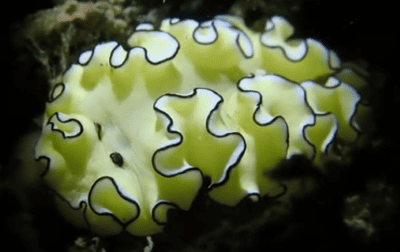 The Indo-Pacific region is well known for its rich biodiversity and you can expect to spot cheesecake nudibranch gliding around the vibrant coral formations.
The Indo-Pacific region is well known for its rich biodiversity and you can expect to spot cheesecake nudibranch gliding around the vibrant coral formations.
Here's the thing:
It has a cream coloured (or pale yellow) flat and oval shaped body, with an unmistakable black border.
By and large, Doriprismatica atromarginata feed on sea sponges and they use a chemical stored in the sponge as a defencive mechanism.
Bloater (Coregonus hoyi)
Even if you belong with the species of freshwater whitefish (subfamily Coregoninae), being called bloaters is not a nice thing right?
They pegged this amusing term to a fish that's native to the very deep waters (198 metres or 650 feet) of all the Great Lakes, except one (Lake Erie).
Why?
In a nutshell, these fish would have a 'bloated' appearance when fishers were bringing them up in nets. At one time, the population suffered - primarily due to the sea lamprey vampire fish and the invasive alewife (Alosa pseudoharengus). But, bloater populations are 'swelling' again - especially in Lake Ontario.
Fairy Basslet (Gramma loreto)
The most striking feature of basslet fish species is the intense colouration. For example, the royal gramma (scientific name Gramma loreto and also called the fairy basslet) is an amazing display of deep purple with a bright yellow back.
Fun Fact: In general, most aquarium enthusiasts find basslets easy fish to take care of and often breed them in captivity.
Slimehead (Hoplostethus atlanticus)
Calling anything 'the slimeheads' sounds like a bit of an insult - and definitely not something you would put on the dinner table. So, seafood marketers rechristened them to (take your pick):
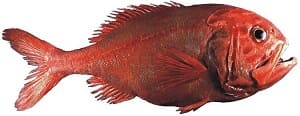 Redfish
Redfish- Orange roughy
- Roughies
In fact, the funny common name relates to the mucous-producing canals on top of the fish's head.'
While we're on the subject of amazing fish facts. The slimehead (Hoplostethus atlanticus) waits until they are more than twenty years old before they start reproducing. Plus, reports suggest they can live for nearly 150 years.
Spotcheck Stargazer (Ichthyscopus sannio)
Yes you guessed it - spotcheck stargazers (Ichthyscopus sannio) are a spotty fish and they are a member of the stargazer fish family.
So, they are good at burying themselves in the sandy substrate and using the eyes situated on top of the head to locate prey.
Bony-Eared Assfish (Acanthonus armatus)
It's fair to say that weird fish names don't get much more humorous than this one. It might be best not to ask, but... How did the bony eared assfish get its name?
Well, you need to go deep down if you want to see an assfish. They live in tropical and subtropical oceans, especially the tropical western Atlantic, at incredible depths of 4,415 metres (over 14,000 feet).
And the persona?
The clue is in its scientific name. Acanthonus armatus evolved from the Greek words akanthos (translated to spine) and onos (meaning a cod-like fish). The Latin word Armatus translates to "being armed".
All clear now? Thought not! A literal translation would go something like... "a fish that looks like a cod arms itself with sharp spines".
Let's try another version. Onos in Ancient Greek refers to an ass (donkey, or domesticated equine) and the rest of the designation refers to the strong spines that look like bony ears.
Tasselled Wobbegong (Eucrossorhinus dasypogon)
You can find this bottom-dwelling species of carpet shark in the shallow reef areas of Australia, Indonesia, and the western Pacific.
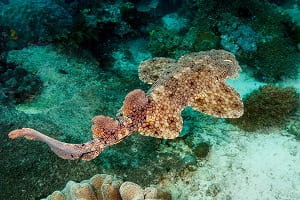 The 'tasselled' stamp refers to the dangling tassels that surround the periphery of its head. It kind of looks like side whiskers or a colourful beard.
The 'tasselled' stamp refers to the dangling tassels that surround the periphery of its head. It kind of looks like side whiskers or a colourful beard.
The wobbegong part?
We understand that it comes from an Aboriginal word that probably translates to something like 'living rock'.
Most carpet sharks are small, measuring about one metre in length (4 feet). The tasselled wobbegong (Eucrossorhinus dasypogon) is one of them that rests motionless on the bottom of the ocean waiting for an easy meal.
Pro Tip: Click through to our diving and snorkeling destinations section if you're searching to find the dive capital of the world (the answer may surprise you).
Pirate Perch (Aphredoderus sayanus)
The forward placement of its cloaca is one of the quirky features about this small freshwater fish. Another one is the use of crypsis (chemical camouflage) to avoid detection.
Why is it called a pirate perch (Aphredoderus sayanus)? Early observations of it eating other fish species is the best answer. Even though the funny fish name stuck, it actually eats the larvae of aquatic insects.
Psychedelic Frogfish (Histiophryne psychedelica)
There are about fifty (50) species of frogfish, and one of the most bizarre has swirling patterns all over its body.
Most of them have yellow and brown body colouration. But the reference to its "mind-bending" appearance (like a fingerprint pattern) comes from the freaky arrangement of its pink and white stripes.
Monkeyface Prickleback (Cebidichthys violaceus)
The monkeyface prickleback (also called monkeyface eel) is the last inclusion in this list of funny scientific names for fish species.
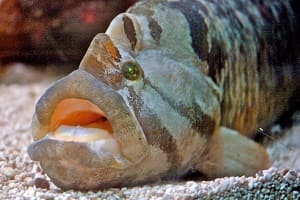 The species, which is actually a fish and not an eel, is widespread around the coastal areas of central California.
The species, which is actually a fish and not an eel, is widespread around the coastal areas of central California.
The derogatory, yet amusing, name comes from its monkey-face-like demeanour and appearance.
But, there's a lot more to learn about the monkeyface prickleback (Cebidichthys violaceus) - a remarkable specimen.
The life expectancy of these fish is something close to fifty (50) years. So, they must enjoy living in rocky, intertidal habitats.
Their staple diet includes several examples of marine invertebrates, including marine mollusks, and aquatic crustaceans
Finally, they are sequential hermaphrodites that start their life as a female. As they develop and get older, some will transition into males in preparation of the breeding process.
Attractive Marine-style Custom Stickers
Make stickers of these marine animals living in a harmonious marine environment and playing with each other, such as:
 Boxing crabs
Boxing crabs- Slimeheads
- Red-lipped batfish
- Dracula shrimp goby
You can also add some marine elements to increase the overall creation of the atmosphere, such as:
- Coral reefs
- Seaweed
- Waves
These creative marine animal Custom Stickers are not only beautiful and interesting but also convey positive messages such as protecting marine ecosystems and biodiversity.
Once you've got your custom ocean-inspired stickers, it's time to start using and sharing them.
You can stick them on notebooks, mobile phones, water bottles, and other items. Children can also stick them on the walls of their rooms to create a dreamy ocean world.